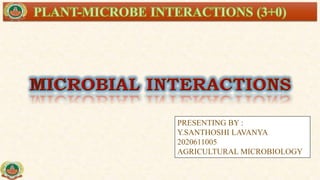1) The document discusses various types of biological interactions that can occur between microbial populations, including mutualism, commensalism, competition, and parasitism.
2) Mutualism provides benefits to both participating organisms and includes examples like rhizobium-legume symbiosis and mycorrhizal associations.
3) Commensalism benefits one organism without affecting the other, while competition negatively impacts both interacting populations by limiting shared resources.
4) Parasitism benefits one organism (the parasite) at the expense of the other (the host).



































